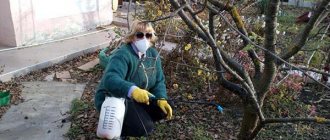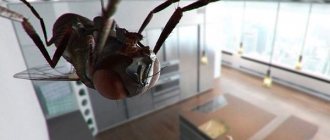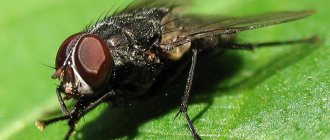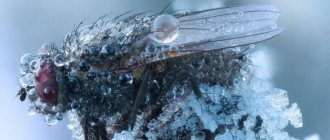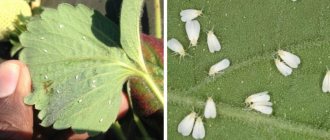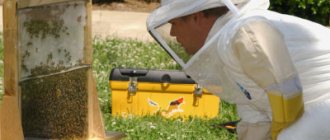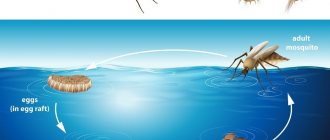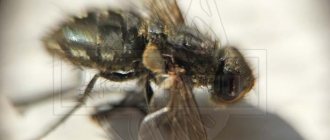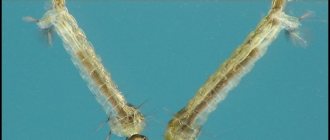Everyone remembers Krylov’s fable “The Dragonfly and the Ant”. According to the plot of this famous story, the first insect was not cooked in winter, after which it got into an unpleasant situation. This is quite real. The lifespan of most dragonflies ranges from 6 weeks to 3-4 months, and with the onset of cold weather they die from low temperatures. But some representatives of the species manage to hide in a secluded place, where they are quite capable of waiting out the frost. But compared to what other insects do from autumn to winter, the dragonfly's search for shelter seems nonsense.
Ants
Different types of ants prepare for winter in different ways. Many hibernate and only wake up in the spring. But some varieties still work. It happens:
- The queen stops laying eggs even before the onset of cold weather.
- Worker ants collect food (seeds, dried plants, fruits, etc.). He is kept in separate cells that are not used for “travel.”
- Before the onset of frost, the ants manage to close all exits from the anthill. To “close doors” they use earth, stones, parts of plants and generally anything they come across.
- Especially for winter, new passages explode in the anthill, deeper than usual. A higher temperature is maintained there due to the fact that the soil at this level does not freeze. It is in these passages that insects survive the cold.
In winter, ants constantly come out of deep passages to eat, feed their offspring, check the temperature, put some passages in order, whether they have opened or collapsed. We can safely say that these insects have one of the most interesting and complex algorithms for preparing for the cold.
LiveInternetLiveInternet
Let's remember what insects we know
- Wings, round eyes, smooth circles... Dragonfly
- He cannot sleep early in the morning - he really wants to work. This means that the honey was brought by a bee... a hardworking one.
- Jump and jump - not a man, jump into the grass... Grasshopper
- Your ear knows how noise is on a summer day. I fly to every house, my name is . I'm flying.
- The next miracle insect is the largest of all the hard workers, sometimes it bites and is called an ant.
- Little red wings, black polka dots. Who is this walking on my palm? Ladybug.
- I feed on nectar, fly on wings. So, have you guessed who I am? Butterfly
- He lives in a dark corner, he weaves a silk thread, he secretly came up here, he was going to build a new house. This is a spider. It is often mistakenly considered an insect, but it belongs to the class of arachnids.
How insects prepare for winter
As soon as summer begins to wane, insects, like many other animals living in our area, begin to prepare for winter. It happens in different ways. It turns out that in Russia, most adult insects do not survive until winter. Their life expectancy is usually short - from several months to one or two days. Some insects, crawling out of the pupa shell and laying eggs, die immediately. It turns out that for the survival of a species it is much more convenient to survive difficult moments at other stages of development - eggs, pupae or larvae. Several dozen tiny eggs lie somewhere behind a piece of peeled bark, oblivious to the winter cold. Under the thinnest shell, they reliably support the life of future six-legged generations. Well, those insects that need to survive until spring intensively gain weight and get rid of water. Of course, it is impossible to get rid of all the water, otherwise the body will die. Therefore, they produce antifreeze, a substance that prevents freezing. Most often it is glycerin. Without it, even slight negative temperatures will lead to the formation of ice crystals that destroy delicate living tissues. With the onset of cold weather, the life processes of the hibernating insect slow down, although they do not stop completely. The insect's cold resistance in this state is simply amazing. Overwintering pupae can withstand temperatures down to -90 degrees, so they develop into normal insects. How to prepare a ladybug for winter? Everyone loves this little beauty because it has a bright, shiny color and is considered a symbol of happiness. However, the insects are not very friendly to each other - they are apparently dreamers who enjoy life alone. But when the leaves begin to fall outside and the air becomes cool, ladybugs unite in groups and look for warm places for wintering, for example, tree bark, moss, and stones. Elegant red and black beads are hidden in the apartments. The main task of the autumn sun is to find a dry and comfortable place to relax. Unfortunately, these insects do not see a snowy winter because they hibernate before it arrives.
How to prepare a dragonfly for winter?
By winter, most dragonflies (with the exception of migratory species) die after laying their eggs in water for the first time. True, the stupid dragonfly does not die, but hibernates and lays eggs only in the spring. The eggs hatch into larvae that live in water for 2-3 years and gradually grow. In the last year of development, the larva turns into an adult dragonfly, which appears in spring for some and in summer for others.
How to prepare a butterfly for winter?
Most butterflies (not counting migratory species) die before winter. But females leave broods of eggs from which caterpillars develop. Some of them manage to turn into pupa in the summer, others remain to spend the winter in different shelters: some hide in the ground, others in spider nests on tree branches. However, among adult butterflies there are wintering ones that do not die, but fall into torpor. These include: urticaria, lemongrass, mourning, multiflorum, daytime peacock's eye. In late autumn, these butterflies climb under fallen leaves, in the root crevices of old stumps, under the bark of trees and in other secluded places. After overwintering, they leave their “shelters” and fly for some time, feeding on plant nectar. The females then lay eggs and die, and a new generation of butterflies, which develop from the eggs (via the caterpillar stage), emerge in the second half of summer and fly in the fall. In winter, butterflies of this generation fall into torpor, and in the spring they behave like butterflies of the previous generation.
How do grasshoppers prepare for winter?
The grasshoppers themselves die in winter, and only the eggs laid in the ground go into hibernation. In the spring, larvae emerge, similar to adults, but smaller in size and wingless. Over time, they develop into sexually mature winged insects.
How does an ant meet winter?
Our two species of wood ants living next to each other have different wintering habits. With the onset of cold weather, large red ants' anthills become empty. The surviving inhabitants form a dense ball at a depth of about one and a half meters in a special winter quarters. At this depth, the soil does not freeze, and the ants sleep peacefully until spring. Surprisingly, ants are much better at making long-term forecasts than weather forecasters. If severe frosts are expected in the coming winter, the wintering depth is increased in advance. The nest of their black cousins, located in a rotten tree stump, is full of numb inhabitants. And these ants will survive safely until spring. There were no special rooms built for wintering on fires. Renovations took place in each of them. With the onset of cold weather, a large amount of glycerol accumulates in the body cells of these ants, which protects them from death. It is thanks to this magical liquid that ants do not freeze in winter.
How do bees winter?
Worker bees do not hibernate during the winter. With the onset of cold weather, the queen stops laying eggs, and the bees spend more and more time in the nest. They all gather around the larvae and pupae to maintain the temperature necessary for their life. In winter, bees do not work and sit almost motionless. The bee ball consists of 30-35 thousand individuals. The temperature inside the ball is always higher than outside. Therefore, frozen bees crawl into the depths, and bees that have been in the heat take their place. The main enemies of bees in winter are strong winds, humidity and hunger, so beekeepers should try to provide the bees with a calm and comfortable winter.
How spiders hibernate.
In autumn, spiders hide to avoid the cold winter. The water spider wraps itself in a cocoon and dives under the water, where it falls asleep until spring. Spiders that live in the forest or in the open air hide in tree bark. And those who scare us at home fall asleep somewhere in the crevices.
What do mosquitoes and flies do in winter?
It is interesting that mosquitoes and flies hide in window frames and cracks of houses during the winter. A hibernating fly can live for six months or more. With the onset of warmth, the flies come to life and walk around as if sleepy. Having recovered, the insects return to their normal lives, which usually lasts about a month. And mosquitoes often do not survive until winter. Adults spend their entire lives on the mainland, namely summer and autumn. This is how all the male mosquitoes die, and the females (and even not all of them) go into bodies of water to wait for winter and spring to lay eggs for the birth of a new life.
Now we know where insects hide in winter: they find comfortable places where they sleep soundly. And now we play snowballs, make a snow woman, celebrate Christmas and New Year and very rarely meet sleepy insects.
Sources:
https://pustunchik.ua/online-school/biology/zoology/yak-komakhy-gotuiutsia-do-zymy
https://shkolazhizni.ru/article/13442/
Observation progress:
1. Organizational moment
We are in a kindergarten group .
- Guys, today we will go for a walk and watch insects . And I ask you to be friendly, attentive and sympathetic.
Educator: Guys, what seasons do you know?
Children: Winter, spring, summer, autumn .
Educator: What time of year is it now?
Children: Early autumn
Educator: Name the signs of autumn .
Children: It’s getting colder, the leaves are falling, the grass and flowers are drying, the days have become shorter, the nights are longer, birds are flying to warmer climes, wild animals are preparing for winter.
Educator: The most important sign of autumn is cooling . Animals, birds, insects are preparing for winter . They all do it differently. Today we will try to see insects and find out how they prepare for winter?
2. Conversation about insects .
Educator: What insects do you know ?
Children: Dragonfly, ant, fly, mosquito, midge, beetle, butterfly, spider, etc.
Educator: What benefits do insects ?
Children: Insects are food for birds , reptiles, they pollinate plants, etc.
(At this time a beetle appears from behind a tree)
Beetle: Hello, who's making noise here?
Children: Hello, this is us, children from the preparatory group . And who are you?
Beetle: Guess the riddle, then you’ll find out.
I don't buzz when I sit
I don't buzz when I sit
If I'm spinning in the air,
I'll have a blast at this point. (BUG)
Children: Please tell me, wise beetle, where do you hide in the fall ?
We, beetles, with the arrival of cold weather, fall asleep soundly, hiding under the bark of trees, dry leaves, in stems, inside last year's blades of grass. So we winter until spring.
My neighbor lives next to me. You will recognize him if you guess the riddle.
Adults and children know
He weaves thin nets,
He is an enemy to flies, not a friend,
What's his name? (SPIDER)
Beetle: Let's ask the spider how he prepares for winter?
Children: Dear spider, tell us how you prepare for winter?
Spider: Hello, I see that you are well-mannered children, you won’t spoil my web. I'll tell you!
In autumn I hide under the bark of trees so as not to face the cold winter. I fall asleep and sleep until spring. The water spider wraps itself in a cocoon and dives under water, where it falls asleep until spring.
Children: Thank you, spider, for your interesting story. We need to move on (say goodbye)
(They come across an anthill)
Educator: What is this, guys?
Educator: How did you guess?
Children: Ants build a house for themselves near the trees in the form of a cone; passages into the anthill are visible here.
He's a real builder
Under a pine tree in a dense forest
Builds a house from needles (ANT)
We always live as one big family. And together we build an anthill house. And we are not afraid of the cold. When winter comes, all the ants hide deep in the house. autumn, our bodies secrete a special fluid that warms us from the inside. It is thanks to her that we do not freeze in winter, but still hide deep underground.
3. Research activity (Look at what parts insects : beetle, ant, spider)
Conclusion: Insects have a head , a back, an abdomen, and 3 pairs of legs attached to the head.
4. Labor activity
Educator: Guys, so that our insects don’t feel cold , let’s collect some leaves and insulate the anthill.
5. Play activities
Outdoor games. "Day and night butterflies"
,
“Catch a mosquito!”
6. Surprise moment.
Beetle: And as a souvenir, guys, I’ll give you some sheets of paper with the task: complete the drawing and color the insect .
- Guys, you were great today, friendly, resourceful and attentive. Share, did you enjoy watching insects ? What did you like most? Now you can play whatever you want.
The walk corresponded to the program content of the child’s age. During the walk , educational, developmental and educational purposes were used.
The teacher’s tone during the walk is even and calm.
At the beginning of the walk , the teacher enriched and activated the children’s vocabulary, formed children’s ideas about changes in the inanimate nature of autumn (it became colder, we put on warm clothes, leaves fell from the trees, birds fly south, etc.)
• Through collective work, achieved a common goal (we insulated the anthill)
and a feeling of joy from the actual work done.
During the outdoor game “Spider”
, the purpose of which was: to teach walking and running in all directions without bumping into each other;
act quickly on the teacher’s signal, help each other. She taught us to show good feelings in the game and not bump into each other. During the walk, individual work was carried out with the children, the main task of which was to jump, pushing off with both legs.
Outdoor game "Spider and flies"
Goal: Strengthening the muscles of the trunk and limbs; improvement of respiratory function; development of reaction speed; coordination of movements; nurturing dexterity and courage.
Inventory: 4 flags, spider mask.
Wild bees
Everything is clear with the wintering of domestic bees - the beekeeper creates the necessary conditions for them. With savages things are much more complicated. With the onset of cold weather, they independently undergo a multi-stage process:
- The uterus slows down and then stops lying down completely.
- Insects stop flying out of the nest. The autumn cold is not scary for adults, but young people need constant warmth. A bee arriving from outside could disrupt the temperature regime.
- With the onset of the first frost, insects gather in a ball or club and practically stop moving. It is typical that the cluster is located on empty cells and only its upper part can touch the cells.
- The bees spend the entire winter in the club. During this period they act as a single unit. Those of them who are cold move to the center, and those who are hungry move to the honeycombs. If a bee gets cold, it moves into empty honeycombs, using them as a blanket.
Preparation for winter begins with the first wave of cold (usually in September) and ends with the onset of November frosts. At the moment, there are already bugs in the club.
Bees
The process of preparing for wintering for wild bees is very complex. With the onset of the first cold weather, the queen stops laying eggs. The closer it gets to winter, the less often bees fly out of the hive. Working individuals from the street bring cold air into the hive, thereby disturbing the temperature regime, and young animals, unlike adults, do not tolerate low temperatures well; cold air is destructive for them. Inside the hive, insects form a ball or ball in which they wait out the cold. Although the bees inside the ball hardly move, life in it does not stop. The top individuals of the ball are located close to the honeycombs with honey, but the bees inside also need to eat, so when they get hungry, they move upward, closer to the food. Individuals that freeze, on the contrary, make their way inside, where it is warmer, or climb into honeycombs, where they warm up. Of course, it is not possible without losing fighters in the cold, but this method helps most of the bee colony survive until spring.
Bee
Beekeepers take care of domestic bees. But the principle of wintering wild and domestic bees is similar. Many bee lovers make the mistake of over-insulating the hive. In this case, a person draws an analogy with domestic animals, which are transferred from open pastures to insulated sheds for the winter. But if in the case of livestock this is a necessity, then for bees such measures are unnecessary. As we know, in winter insects feed on honey, while they release moisture. Increased humidity inside the hive is created, the honeycombs become moldy, and the bees suffer from heat and dampness. By the end of winter, many families die. Bees often live better in hives with slits or a pushed-off lid than in well-prepared, insulated hives.
Autumn metamorphoses. What happens to insects in the fall and where do they disappear?
Fall. The leaves fall, everything around becomes empty and bare. There is no summer abundance of birds; animals have become less noticeable. Insects also disappear somewhere. Until recently, they ran at every step: they flew through the air, crawled along the branches of trees and bushes, and jumped into the grass. And now they can be found with great difficulty: sometimes a lonely butterfly turns into a late flower, a lazy fly buzzes. It depends on everything and everyone
The life of insects directly depends on many factors: temperature, humidity, nutrition, light, etc. Being ecologically plastic, insects easily adapt to any living conditions. In our temperate climate, with strong fluctuations in the most important environmental factors throughout the year, insects have evolved adaptive responses to changing seasons. Thanks to them, these creatures can live and develop in different weather conditions. And this, in turn, is reflected in the specific seasonal cycles of each species. In winter, insects are dormant, which allows them to survive the unfavorable period. Their active life (growth, development, reproduction) occurs in the warm season and lasts from early spring to late autumn - 6-7 months. Autumn is not the most favorable period for the life of insects, on the one hand, due to weather conditions, and on the other, due to lack of food. Unstable weather with sudden changes in temperature - from hot days to frost, as well as alluvial rains negatively affect their activity. Also in autumn, plants stop growing and developing and become unsuitable for nutrition. Therefore, many insects lead an active lifestyle in the spring and first half of summer, when plants contain a large amount of nutrients.
Who cares about the cold?
But there are insects that lead an active lifestyle in the fall. This includes species that are scheduled to develop this season, as well as species that have two or more generations per year. These are some species of butterflies, saws, beetles, homoptera and other insects. In some species, adult insects are active in the fall, dispersing, reproducing, and laying eggs. These species include aphids (green apple, raspberry, plum cane, gooseberry, apple plantain), apple honey, sheath (comma apple, willow), butterflies (pepper, winter and night currant), gingerbread, pine, etc. Species, while feeding of larvae is observed. These are shield acacia, butterflies (apple and plum moths, gooseberry moths, kidney moths, apple ermine), mosquitoes (Scots pine, yellow currant, black-spotted strawberry, spot poplar), garden beetle, sprout and others. In autumn, the largest number of species occurs in September, while it is still relatively warm and there is food. So, on hot and sunny days, lovers of nectar and pollen gather on still flowering plants (for example, umbrella plants) - daytime butterflies, wasps, bees, pollen beetles, parasitic hymenoptera, flower flies. The still green leaves of trees, shrubs and herbaceous plants are eaten by butterfly caterpillars, sawflies and beetles. Aphids and false shields continue to suck up plant sap. Hunting for predatory beetles: ladybugs, cockroaches. Mosquitoes and midges fly in the air, and sometimes butterflies and dragonflies fly. There is also activity on the surface of the soil: ants are running around, preparing their food. In short, many insects lead an active lifestyle. But gradually autumn comes, it becomes colder and colder. For insects, their free life ends: it’s cold, there’s no food and, of course, there’s no time for “songs.” It's time to think about how to escape the cold.
In fact, insects are not as helpless as many people think. The onset of winter does not take them by surprise, because preparation for the cold begins long before their arrival. For many insects, a smooth transition from active life to a state of winter dormancy begins in the second half of summer - early autumn. And by the end of autumn, most insects are already in a state of winter dormancy. But in some particularly frost-resistant species (winter moth, red dormouse, winter mosquito and some others), active life can continue until late autumn and even early winter.
The transition to a different winter lifestyle for insects is one of the most crucial periods. Their future fate will depend on how they prepare for winter: whether they will withstand the winter cold or die. Winter is a serious challenge, so the main task of insects is to cope with it fully armed. How do insects know when their active life is running out? Climatic factors tell them this: temperature, humidity and, above all, light. The biochemical composition of food plants is also of great importance for insects. With the help of these factors, nature, through the nervous and endocrine systems, influences the life activity of insects and programs their seasonal cycles. The reaction of insects to detected environmental factors has an important adaptive significance: it ensures timely restructuring of the body. At the same time, restructuring is taking place both qualitatively and quantitatively. During the transition to winter dormancy, the water ratio changes in the tissues of the insect’s body; they accumulate nutrients. At the same time, the body's metabolism and gas exchange slow down. This inhibited state of the body is a reliable protection against freezing.
What insects can you find in the fall?
What insects are found in the fall (September, October, November), you will learn from this article.
What insects can you find in the fall?
With the arrival of autumn, nature gradually prepares for winter; some animals hibernate. Also, with the arrival of cold weather, insects look for a warmer place in order to survive the winter and meet the sun again.
What insects can you see in September?
September is perhaps the warmest autumn period, when summer has not yet ended and autumn has not fully come into force. And some insects are still basking in the sun and at the same time preparing for hibernation. In September we can still observe the active work of ants, bees and ladybugs. The air is also scattered with flies and mosquitoes, beetles, beautiful butterflies and dragonflies. The sound of a grasshopper is heard in the grass. They begin their preparations for winter. Each in his own way.
What insects can you see in October?
In October, ants and bees and wasps and beetles continue to settle down for the winter. Less frequently, but still audible are the squeaks of mosquitoes and the crackling of grasshoppers and crickets. From time to time, butterflies and dragonflies and ladybugs and fireflies delight the eye. But bumblebees and wasps have practically set up their hives and are leaving them less and less often.
What insects can you see in November?
November is the last and coldest month of autumn. Therefore, already at this time all insects are in a state of hibernation, oblivion or the formation of pupae. The only thing is that in the cracks of the walls of houses where it is warm, you can see annoying mosquitoes or even flies. But this is very rare.
We hope that from this article you learned what insects can be seen in the fall.
Source
Mosquitoes and flies
These pesky insects prepare for winter just like butterflies. In autumn they look for a warm place to sleep and survive the cold. But flies and mosquitoes try to get close to people whenever possible. Instead of piles of leaves, they have basements, cellars, sheds and even houses.
It is interesting that only females, eggs and pupae overwinter in mosquitoes - the males die before the onset of cold weather. The same situation is with wasps and hornets.
At what stage of development do insects overwinter?
ABOUT BEETLES IN AUTUMN (author: Astrakhantseva O.A.)
Autumn days are getting shorter. Insects are very cold -
Monkey:
Look - ants! Aphids are milked on a birch leaf. How do ants spend the winter? Orangutan: Ants hibernate on the lower floors of the anthill, deep underground. They do not become confused, but their activity decreases. Together with them, aphid eggs are taken into the anthill, and in the spring they are planted on young leaves. For them, aphids are the same as cows for humans. The sweet secretions of aphids in the ants' bodies are converted into glycerol and help them stay warm in winter. Meerkat: How many bees are on these marigolds and on these plums!
Orangutan
: These are not bees. These are striped hoverflies that imitate the color of a bee. A fly has two wings, and a bee has four. Closer to autumn, hoverflies become especially numerous. Meerkat: Do these hoverflies bite painfully? Orangutan: Hoverflies cannot bite, they do not have a sting. And they copy bees so that their enemies don't eat them. Hoverflies are also called musicians.
Walk “Insects in autumn” (preparatory group)
Theme: Insect in autumn
Goal: summarize children's knowledge about insects .
Objectives by educational areas:
• Develop the ability to establish connections between the features of the external structure of an insect and the method of movement, the method of protection from enemies.
• Form spatial orientation.
• Strengthen children's knowledge about the diversity of insects .
• Distinguish and find insects by characteristic features, stimulating cognitive interest in the process of research activities.
• Develop the ability to distinguish insects .
• Develop cognitive activity
• Develop the ability to select adjectives - characteristic features of the subject.
• Foster a humane attitude towards all living things.
• Form friendly relationships with peers, the ability to work in pairs.
• Ensure motor activity of children while walking , exercise children in jumping, develop attention, reaction speed, spatial orientation, dexterity, accuracy of actions.
• Insects
ladybugs
These harmless and cute guys are especially interesting. In summer, they are completely indifferent to other representatives of their species and do not even notice it. But before the onset of cold weather, ladybugs begin to look for their species and gather in flocks numbering several hundred and sometimes thousands of individuals. Together they find a warm shelter (it can be anything) and hibernate.
Interestingly, the herd uses the same place every year.
Having observed how insects prepare for winter, we can draw an unambiguous conclusion. They are not as stupid as they seem. Of course, all this happens at the level of instinct, but the complex processes of wintering seem very interesting and even instructive to some extent.
Spiders
Many will be surprised, but these insects are found in every home and in very large quantities. In the fall, spiders begin mating season, so they begin to look for a secluded place.
And human dwellings are best because they are warm, dry and food can be found.
If you don't want such neighbors, then do a thorough cleaning, remove all the cobwebs and don't leave the outside lights on at night.
When all the insects disappeared in the fall, the world around us
Monkey:
What to do here? Meerkat: I got it! It is necessary to recognize the animals in the pictures and write their names in the cells that are nearby. Monkey: Why are the images connected by arrows? Meerkat: It's a sequence. Monkey: What sequence? Meerkat: Letters in a word must be written in green cells. Monkey: You'll probably have to enter the letters with which the names of the animals begin. Who's in the first photo? Meerkat: I know it! It's a porcupine! Monkey (writes with a pencil in the cells under the picture, sticking out his tongue with zeal): PORCURE. Happened! Meerkat: So wintering begins with the letter D! Orangutan: What good guys you are! You figured out how to untangle the tangle!
Club beetle
The stick beetle is a small insect with a characteristic black and red pattern on its back. Typically, this pest rarely causes problems even for gardeners. The only thing that is “dangerous” to others are obvious marks on the walls. So, if you live in a private house, these insects will often come to visit you, especially in the fall, when cold weather is approaching. They are much more comfortable in the cracks and crevices of your warm home. If you are not ready to constantly remove traces of your movements from a light background, you can try to get rid of these annoying neighbors.
Silverfish
If you once took a warm sweater out of the closet and found small holes in it, it is not because it is old and pretty worn out. This is the work of silverfish. These little silver-colored bugs feed on carbohydrates and simple sugars found in the fibers of natural tissues. In addition, they love an abundance of moisture, so they often live in large numbers in the bathroom and toilet. A special insecticide, which can be bought at any specialty store, will help get rid of them.
Other pests
In addition to the types of insects listed above, there are a large number of harmful insects, which in most cases wait for the winter on the plots. Some types of pests, such as caterpillars, crawl under the bark of trees, under fallen leaves, in uncleaned grass and dead bushes. Caterpillars, as a rule, turn into pupa and overwinter in this form. Other garden pests, such as aphids and spider mites, lay their eggs over the winter and hatch into young, voracious insects when spring arrives. Other types of parasites, such as spider mites, simply go deeper into the ground, where conditions favorable for their survival remain, and wait for the winter in diapause. During this period, all processes in the insect’s body slow down. They don't move, don't eat, and barely breathe. The substances accumulated in the intestines over the summer are sufficient to maintain life in the insect’s body until spring. When the air temperature rises to 12-14 degrees Celsius, insects come to the surface and actively continue their life activities.
Wasps
Most wasps and hornets die by autumn. Only young females remain alive and are capable of reproducing offspring. They, like many insects, overwinter under the bark and in cracks of trees, in a pile of fallen leaves or withered grass, and use rotten stumps or trunks of fallen trees for overwintering. During this period, vital processes practically cease, and insects become insensitive to low temperatures. The wasp body produces a substance similar in properties to antifreeze. It prevents the fluids in the wasp's body from crystallizing.
Wasp
With strong fluctuations in outdoor temperatures, the chemical composition of the cells in the wasp’s body changes, which is why the substance “antifreeze” ceases to be produced. When the temperature drops, the liquids crystallize, which leads to the death of the wasp queen.
Butterflies
Some butterfly species migrate to warmer regions in the fall. The most famous species of migratory butterfly is the monarch. They are able to travel thousands of kilometers; air currents help them in this. This species of butterfly lives in North America, but Russia also has its own nomadic butterflies, for example, burdock. The first generation of butterflies arrives in the middle zone in late May - mid-June, the second generation - in mid-July - early October. And this second generation will most likely return south for the winter.
Butterfly hives
Some butterflies, such as the urticaria, wait for the cold in the middle zone. To survive in frosts, butterflies hide under the bark of trees, under fallen leaves, in the undergrowth, where conditions are acceptable for life.
But most butterflies, due to their short life, do not live until autumn, but leave offspring in the form of eggs and caterpillars. The eggs are stored until spring, and in the spring the caterpillars hatch. And the caterpillars pupate, which allows them to survive in this form until spring.
Where do insects disappear from gardens and vegetable gardens in the fall?
In summer, insects are literally everywhere. Some species are pleasing to the eye or beneficial, while others, on the contrary, cause a lot of trouble. But with the arrival of autumn everything changes.
Insects do not accumulate fat, like marmots or bears, so nature has developed special methods to wait out frosts.
Some species fly to warmer climes, some die, leaving behind offspring, and some try to survive in unfavorable conditions. Let's look at common wintering options for insects.
Bees
The process of preparing for wintering for wild bees is very complex. With the onset of the first cold weather, the queen stops laying eggs. The closer it gets to winter, the less often bees fly out of the hive.
Working individuals from the street bring cold air into the hive, thereby disturbing the temperature regime, and young animals, unlike adults, do not tolerate low temperatures well; cold air is destructive for them. Inside the hive, insects form a ball or ball in which they wait out the cold.
Although the bees inside the ball hardly move, life in it does not stop. The top individuals of the ball are located close to the honeycombs with honey, but the bees inside also need to eat, so when they get hungry, they move upward, closer to the food.
Individuals that freeze, on the contrary, make their way inside, where it is warmer, or climb into honeycombs, where they warm up. Of course, it is not possible without losing fighters in the cold, but this method helps most of the bee colony survive until spring.
Bee
Beekeepers take care of domestic bees. But the principle of wintering wild and domestic bees is similar. Many bee lovers make the mistake of over-insulating the hive. In this case, a person draws an analogy with domestic animals, which are transferred from open pastures to insulated sheds for the winter.
But if in the case of livestock this is a necessity, then for bees such measures are unnecessary. As we know, in winter insects feed on honey, while they release moisture. Increased humidity inside the hive is created, the honeycombs become moldy, and the bees suffer from heat and dampness. By the end of winter, many families die.
Bees often live better in hives with slits or a pushed-off lid than in well-prepared, insulated hives.
Ants
Overwintering of ants depends on the species - some species hibernate, and some do not stop working all winter. We will tell you more about the latter.
Ants
Long before the cold weather arrives, the queen ant stops laying eggs. Working individuals stock up on food for the winter - plants, berries, fruits, seeds. They store it in specially dug compartments. At the same time, other individuals make deeper passages in the anthill.
Insects seal the entrances and exits from the anthill with pebbles, sawdust, pine needles, and earth so that cold air does not get inside. The entire ant family moves deeper into its home.
Due to the fact that the ground at such a depth does not freeze, the temperature in the entrances remains high, which allows the ants to wait out the winter.
Mosquitoes and flies
With the onset of autumn, annoying insects look for a secluded warm place.
Most often, they move closer to a person’s home, hiding in cracks and joints on the floor and walls, in wooden window frames, in basements and sheds.
In winter they fall into a state of diapause, and in the spring they wake up and continue their life activities. Sometimes, when the temperature outside the window rises in the fall, you can see sleepy flies or lethargic mosquitoes in the house.
Fly
It is noteworthy that only female mosquitoes, eggs and larvae remain to wait out the cold; the males die at the end of summer.
Mosquito
Butterflies
Some species of butterflies fly to warmer climes in the fall. The most famous species of migratory butterfly is the monarch. They are able to travel thousands of kilometers; air currents help them in this.
This type of butterfly lives in North America, but Russia also has its own traveler butterflies, for example the burdock. The first generation of butterflies arrives in the middle zone in late May - mid-June, the second generation - in mid-July - early October.
And this second generation will most likely fly back to the south for the winter.
Butterfly hives
Some butterflies, such as the urticaria, remain to wait out the cold in the middle zone. To survive in frosts, butterflies hide under the bark of trees, under fallen leaves, in brushwood, where conditions acceptable for life are created.
Scientists say that insects are threatened with extinction, and this will result in a disaster for the entire ecosystem of the Earth. The overall insect population is declining by 2.5 percent per year. At this rate, they could disappear within a century, reports The Guardian.
Tanguy Sauvin
The report cited by the newspaper was written by scientists from the Universities of Sydney and the University of Queensland, as well as the Chinese Academy of Agricultural Sciences in Beijing. They examined 73 scientific studies on insect declines published over the past 30 years and analyzed the reasons for this.
The number of 40 percent of species has decreased, a third of them are at risk of complete extinction. In mammals, birds and reptiles, the extinction rate is eight times lower.
Scientists are convinced that the sixth mass extinction has begun on Earth, caused not by nature, but by human activity. It is believed that during the Phanerozoic (the last 540 million years) there were five global catastrophes on Earth, when a proportion of the species of a large number of higher taxa died within a short geological time period.
Researchers have noted declines in many animal species, but their populations are easier to track than insects because of their abundance and diversity.
Causes
The analysis, published in the journal Biological Conservation, indicates that the main cause of insect extinction is the use of pesticides in agriculture. Urban growth and climate change are the next most important factors.
The process began, researchers suggest, at the beginning of the 20th century, accelerated in the 1950s and 1960s, and reached “threatening levels” in the last two decades.
Scientists at the University of Sydney believe that the most harmful are new classes of insecticides that began to be used in the last 20 years, including neonicotinoids (a synthetic insecticide similar in action to nicotine) and fipronil (an insecticidal agent actively used to kill ants, cockroaches, moly). They are regularly used in agriculture and accumulate in the environment.
The conclusions of foreign scientists were confirmed to Snob by Doctor of Biological Sciences Anatoly Zakharov.
According to him, the trend of gradual extinction of insects is associated both with the general deterioration of the environment and with the fact that the habitats of many of them are extremely fragile and unstable to anthropogenic influence.
Moreover, many insects are found in only one region of the Earth, and therefore they become extinct faster than mammals. If this habitat is destroyed during the construction of a road or factory, the entire species will automatically be destroyed.
What does this threaten?
Francisco Sanchez-Bayo, from the University of Sydney, said the insect extinction rate of 2.5 per cent a year was "shocking". "It's very fast. In 10 years we will have a quarter less insects, in 50 years - only half, and in 100 years there will be none,” the scientist said.
About 80 percent of wild plants cannot be pollinated without insects, and for 60 percent of birds they are food. The threat of insect extinction is the extinction of insectivorous birds. There is also a risk that larger birds will start eating smaller birds.
It is well established that humanity is rapidly losing butterflies and moths, bees and wasps, beetles (mainly dung beetles) and dragonflies. However, scientists note that a lot of research has been carried out on these insects. Flies, ants, aphids, bedbugs and crickets have been studied extremely little, but there is no reason to believe that their populations are not declining.
The report notes that while the overall number of insects on Earth is declining, a small group of those that are able to adapt have shown an increase in numbers. But this, according to scientists, is far from enough to restore losses.
The studies analyzed in the report were conducted in Western Europe and the United States, as well as in Australia, China, Brazil and South Africa, among other countries.
It’s interesting that insects have been fine for the last 500 million years, and all apocalyptic forecasts concern humanity rather than them, ecologist Sergei Zabelin tells Snob. In his opinion, insects will figure it out, but people will not.
A particular threat is the decline in the number of insects that pollinate crops: ultimately, this can lead to people having nothing to eat. “If they are gone, we will chew plastic.
If insects disappear, our main food products will disappear,” Sergei Zabelin is sure.
How can I fix the situation?
Sánchez-Bayo pointed out that the way we grow food needs to change. He notes that organic farms had a lot of insects, and that earlier use of pesticides did not lead to the colossal levels of extinction that we see today. “Industrial agriculture is killing ecosystems,” the scientist emphasized.
In the tropics, where there is virtually no industrial agriculture, the main harmful factor is rising temperatures due to climate change. The species of insects that live there are accustomed to stable conditions and adapt with great difficulty.
Authors: Arina Kochemarova, Arina Kryuchkova, Ksenia Pravednaya
Source: https://snob.ru/entry/172258/
How to make a hunting belt for studying insects
Orangutan:
And we'll make artificial bark for them! People have long been fighting pests of fruit trees using trap belts. The logs are wrapped in sticky, poisonous strips to encourage insects to crawl in for shelter, then the straps are removed to kill the pests. Meerkat: But we’re not going to destroy anyone, are we? Orangutan: We don't! We are redesigning the belt to become a tool for learning about fall insects.
Materials (edit
: Corrugated cardboard for packaging. Scissors, twine (rope). 1. We will make strips 10-15 cm wide from corrugated packaging cardboard; the length will determine the circumference of the tree trunk on which you will place the belt. 2. In dry weather (preferably a couple of days), wrap a strip of cardboard around the tree trunk at a height of 50 cm from the ground and do not tie it too tightly with rope. There should be gaps between the cardboard and the barrel.
1) Remember and tell what natural phenomena can be observed in autumn, winter and spring.
We read about all this in Pleshakov’s textbook “The World Around us”.
We use the knowledge gained: In autumn you can see such natural phenomena as falling leaves, prolonged rains, frosts, freezing, the flight of migratory birds to the south, and a reduction in the length of daylight hours.
In winter you can experience snowfall, snowstorm, and thaw.
In winter, the days are shortest and the sun rises lowest above the horizon.
In spring, you can observe such natural phenomena as the melting of snow, drops, thawed patches, ice drift, the return of birds from the south, the appearance of the first flowers, insects, and leaves on the trees.
Sunny days increase in spring, and summer is ahead of us.
2) These plants can be seen in summer. Find out their names using the atlas-identifier.
1. This is meadow cornflower.
2. This is chicory
3. This is a forest geranium
4. This is a bedstraw
5. This is meadowsweet.
Crickets
Another gardener's headache is crickets. These insects not only settle absolutely everywhere, preventing their inhabitants from sleeping and resting, but also indiscriminately eat everything. They will squeeze out any plants, paper, fabric, putty on the windows. In general, a real plague. Gardens, vegetable gardens and private homes are attacked by these pests in the fall, when food is needed. Crickets hide in dark, warm corners of the house or garden. You may realize that there are crickets in your home with distinctive droppings that look like ground coffee particles.
How to get rid of:
- Before the cold weather sets in, seal all the cracks and cracks in your home's windows and doors.
- Remove all bags of fallen leaves, mulch and firewood from the entrance to your home or garden.
- Various chemicals can be tried, but their effectiveness has not been proven. Check with a specialist in the store.
- Used to control bird crickets. Hang birdhouses in the area and attract birds to the garden. They will eat harmful insects and save you from headaches. Hedgehogs and snakes are also great for controlling crickets.
- Distribute boxes of pest bait throughout the area. Gel and granular varieties, such as Delicia, perform well.
Source – https://sadovnic.su/babochki-i-mushki/chto-proishodit-s-nasekomymi-osenyu.html
Bedbugs
These little bloodsuckers can enter the house in a variety of ways: through cracks in the wall, on clothing, in a suitcase or on the upholstery of a car. Once in the house, they can enter your bed, feeding on your blood while you sleep. Bedbugs, as a rule, do not carry any diseases, and also do not bite too painfully, but the affected areas will itch for a long time. If you want to protect yourself from these insects, then when autumn comes, inspect all mattresses. If you find small brown spots, they should be treated with special products.
Insects in the house are always an unpleasant problem. Therefore, before the onset of cold weather, it is better to restore order, do general cleaning and take preventive measures aimed at combating them.
Found a violation? Report content

